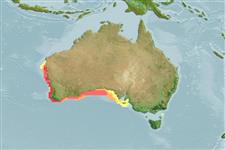Common names from other countries
Пластиножаберные (акулы и скаты) (sharks and rays) >
Orectolobiformes (Carpet sharks) >
Orectolobidae (Carpet or nurse sharks)
Etymology: Orectolobus: orektos (Gr.), stretched out; lobus (L.), from lobos (Gr.), rounded projection or protuberance, referring to long nasal barbels of Squalus barbatus (=O. maculatus). (See ETYFish); hutchinsi: In honor of J. Barry Hutchins (b. 1946), Curator of Fishes, Western Australian Museum (Perth), who first reported this shark as a new species in 1983. (See ETYFish).
More on authors: Last, Chidlow & Compagno.
Environment: milieu / climate zone / depth range / distribution range
экология
морской демерсальный; пределы глубины 0 - 106 m (Ref. 58024), usually 0 - 79 m (Ref. 58024). Tropical
Eastern Indian Ocean: Western Australia. Sympatric with O. maculatus and O. ornatus.
Size / Вес / Возраст
Maturity: Lm ? range ? - ? cm
Max length : 149 cm TL самец/пол неопределен; (Ref. 58024)
Краткое описание
определительные ключи | морфология | морфометрия
Diagnosis: A moderate-sized species with the following characters: yellowish-brown when fresh with well-defined, darker brown saddles; absence fo white spots, blotches or reticulations on the fins and body; nasal barbel bilobed; postspiracular lobes are simple, reduced or rudimentary; distance across preorbital lobe group 1.2-1.3 times interspace between preorbital group and postspiracular lobe, 13-15 times base length of anterior postspiracular lobe; base of anterior postspiracular lobe 11-12 in its distance from postorbital group, 4.9-7 in its distance from posterior postspiracular lobe; mouth width 4.7-10.2 times preoral distance; warty tubercles absent on back of adult; juveniles with rows of elevated denticles or poorly defined warty tubercles on back; dorsal fins raked posteriorly; first dorsal fin over rear half of pelvic -fin bases; interdorsal space 0.38-0.56 times anal-fin base length; anal-fin inner margin 0.8-1.1 times anal-fin posterior margin; teeth in upper jaw 25-27, those in the medial row at symphysis rudimentary; spiral valve turns 26-28; monospondylous centra 48-50 (Ref. 58024).
Males mature at about 111 cm TL. Young born at 22-26 cm TL (mean 24.1 cm TL based on 40 specimens). Caught as by-catch of local gillnet, longline, rock lobster and recreational fisheries (Ref. 58024).
Life cycle and mating behavior
Maturities | размножение | Spawnings | Egg(s) | Fecundities | личинки
Last, P.R., J.A. Chidlow and L.J.V. Compagno, 2006. A new wobbegong shark, Orectolobus hutchinsi n. sp. (Orectolobiformes: Orectolobidae) from southwestern Australia. Zootaxa 1239:35-48. (Ref. 58024)
Статус Красного Списка МСОП (Ref. 130435)
CITES (Ref. 128078)
Not Evaluated
Угроза для людей
Harmless
Использование человеком
дополнительная информация
инструменты
Специальные отчеты
Скачать в формате XML
ресурсы в Интернет
Estimates based on models
Preferred temperature (Ref.
115969): 17.4 - 22.3, mean 18.3 (based on 126 cells).
Phylogenetic diversity index (Ref.
82804): PD
50 = 0.5012 [Uniqueness, from 0.5 = low to 2.0 = high].
Bayesian length-weight: a=0.00389 (0.00180 - 0.00842), b=3.12 (2.94 - 3.30), in cm Total Length, based on all LWR estimates for this body shape (Ref.
93245).
Trophic level (Ref.
69278): 4.0 ±0.6 se; based on size and trophs of closest relatives
Fishing Vulnerability (Ref.
59153): Very high vulnerability (89 of 100).
